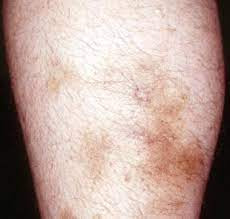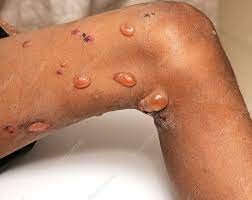Definition
Lichen planus is characterized by inflammation and irritation of the skin, hair, nails, and mucous membranes due to an immune system disorder. This condition is not contagious, yet it can affect individuals of all ages.
On the skin, lichen planus manifests as purplish, itchy, flat-topped bumps that develop over several weeks. These bumps may be itchy or not. In the mouth, vagina, and other mucous membrane-covered areas, lichen planus appears as white, lace-like patches, occasionally accompanied by painful sores.
Most mild cases can be managed independently. However, severe pain or itching may require medical treatment.
Lichen planus most commonly affects individuals aged 30–60 years, though adolescents and children may also experience it.
Causes
Lichen planus is caused by an autoimmune disorder, where the immune system mistakenly targets its cells. In lichen planus, the immune system primarily attacks skin and mucous membrane cells. The exact cause of this immune system abnormality remains unknown.
Risk factor
Anyone can develop lichen planus, but it predominantly affects middle-aged adults. Oral lichen planus is particularly common among middle-aged women.
Lichen planus may be triggered by several factors, including:
- Genetic factors
- Hepatitis C infection
- Flu vaccines
- Certain pigments, chemicals, and metals
- Pain relievers like ibuprofen and naproxen
- Specific medications for heart disease, high blood pressure, or arthritis
Symptoms
The signs and symptoms of lichen planus vary depending on the affected area. Typical signs and symptoms include:
- Purplish, flat-topped bumps, often on the inner forearms, wrists, or ankles, and occasionally on the genitals
- Itching
- Blisters that break to form scabs
- White, lace-like patches in the mouth, on the lips, or tongue
- Painful sores in the mouth or vagina
- Hair loss
- Changes in scalp skin color
- Nail damage or loss
Diagnosis
A doctor diagnoses lichen planus based on symptoms, medical history, physical examination, and supportive tests if necessary.
Common supportive tests include:
- Biopsy: A small tissue sample is examined under a microscope to identify patterns characteristic of lichen planus.
- Hepatitis C test: Blood tests for hepatitis C, a known trigger of lichen planus.
- Allergy tests: A referral to an allergist or dermatologist to determine if allergies may trigger lichen planus.
- Other tests: Depending on suspected variations of lichen planus affecting the esophagus, genitals, ears, or mouth.
Management
Skin lichen planus often resolves on its own within months to years. When mucous membranes are involved, treatment may take longer and can recur. Regular annual doctor visits are essential to monitor the condition and treatment progress.
Medications and other treatments can relieve itching, reduce pain, and speed healing. Discuss treatment options with your doctor. Possible treatments include:
- Corticosteroids: Typically the first choice, corticosteroid creams or ointments are prescribed. If ineffective or the condition worsens, oral or injectable corticosteroids may be recommended. Common side effects include irritation, skin thinning, or mouth sores. Corticosteroids are safe for short-term use under medical guidance.
- Oral anti-infective drugs: Medications like hydroxychloroquine and metronidazole are used in certain cases.
- Immune response drugs: Severe cases may require immune-suppressing or modifying drugs like azathioprine, mycophenolate, cyclosporine, and methotrexate.
- Antihistamines: Oral antihistamines can alleviate itching.
- Light therapy: Phototherapy with ultraviolet B (UVB) light can help clear skin lichen planus. This therapy, conducted 2-3 times a week for several weeks, is not recommended for individuals with dark skin due to the risk of prolonged skin discoloration.
- Retinoids: If unresponsive to corticosteroids or light therapy, oral retinoids like acitretin may be prescribed. Retinoids can cause birth defects, so they are not recommended for pregnant women or those planning to conceive. Pregnant or nursing women should delay topical retinoid therapy or seek alternative treatments.
Managing triggers
If a doctor suspects lichen planus is related to triggers like hepatitis C infection, allergies, or medications, other treatments may be necessary. This might include changing medications or avoiding allergens. Referral to an allergist or liver specialist may be required for managing hepatitis C.
Lifestyle and home remedies
Good self-care can help alleviate itching and discomfort caused by lichen planus. These include:
- Bathing in oatmeal-infused water followed by moisturizing lotions
- Applying cold compresses to affected skin areas
- Using over-the-counter hydrocortisone creams or ointments containing at least 1% hydrocortisone if not using prescription corticosteroids
- Avoiding scratching or injuring the skin
For oral lichen planus, maintaining good oral hygiene and regular dental visits can help manage symptoms. Reducing mouth sore pain involves avoiding:
- Smoking
- Alcohol consumption
- Spicy or acidic foods and drinks
Alternative treatments
Some small-scale clinical trials have suggested that aloe vera gel may help treat oral lichen planus. Additionally, therapies to alleviate stress, which can exacerbate lichen planus symptoms, may be beneficial.
Consult your doctor before trying alternative treatments for lichen planus, as some alternative medicines or vitamin supplements can cause serious reactions when combined with prescription medications.
Complications
Complications of lichen planus include:
- Difficulty in treating lichen planus on the vulva and vagina, leading to severe pain and possible scarring
- Long-term sexual dysfunction
- Mouth sores affecting the ability to eat
- Darker skin pigmentation after the rash resolves, especially in individuals with dark skin
- Increased risk of oral cancer with oral lichen planus
- Untreated lichen planus in the ear canals can lead to hearing loss
Prevention
Since the exact cause is unknown, preventing lichen planus is challenging. The best approach is to avoid known risk factors, such as:
- Quitting smoking and alcohol consumption
- Avoiding habits like biting the tongue or inner cheeks
- Regular dental check-ups, particularly for dental issues
- Routine health check-ups if at risk for conditions like hepatitis C
- Discussing potential side effects of medications with a doctor
When to see a doctor?
Consult a doctor if you notice unexplained bumps or rashes on your skin. Also, seek medical advice for symptoms related to lichen planus in the mouth, genitals, scalp, or nails.
Early diagnosis and treatment can prevent symptom worsening and complications.
Looking for more information about other diseases? Click here!
- dr Anita Larasati Priyono
Lichen planus. (2021). Retrieved 27 April 2022, from https://www.mayoclinic.org/diseases-conditions/liken-planus/symptoms-causes/syc-20351378
Chuang T. (2020). Lichen planus clinical presentation. Retrieved 27 April 2022, from https://emedicine.medscape.com/article/1123213-clinical
Ellis E. (2019). Lichen planus. Retrieved 27 April 2022, from https://www.healthline.com/health/liken-planus
Lichen planus. (2020). Retrieved 27 April 2022, from https://www.nhs.uk/conditions/liken-planus/
Felman A. (2017). Everything you need to know about lichen planus. Retrieved 27 April 2022, from https://www.medicalnewstoday.com/articles/184866#treatment











